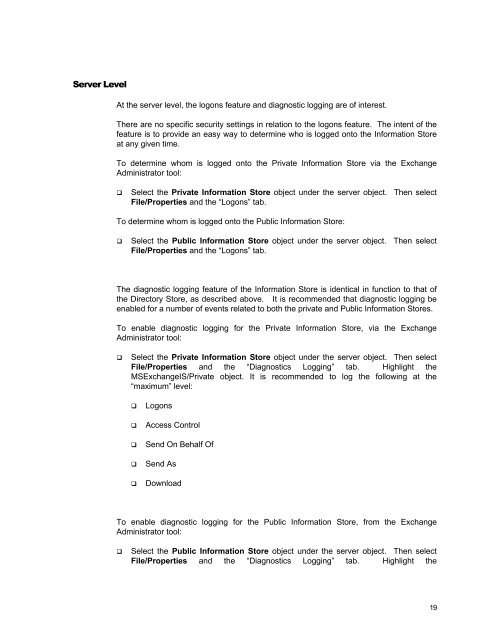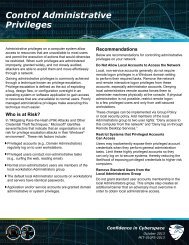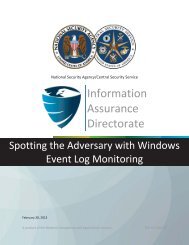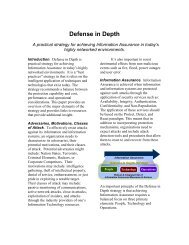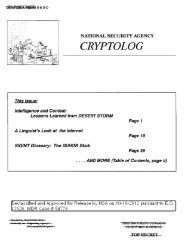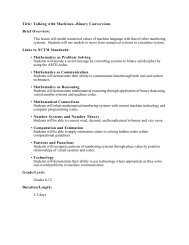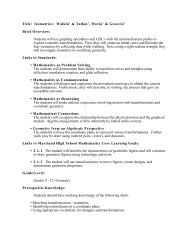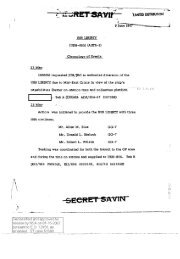Guide to the Secure Configuration and Administration of Microsoft ...
Guide to the Secure Configuration and Administration of Microsoft ...
Guide to the Secure Configuration and Administration of Microsoft ...
You also want an ePaper? Increase the reach of your titles
YUMPU automatically turns print PDFs into web optimized ePapers that Google loves.
Server Level<br />
At <strong>the</strong> server level, <strong>the</strong> logons feature <strong>and</strong> diagnostic logging are <strong>of</strong> interest.<br />
There are no specific security settings in relation <strong>to</strong> <strong>the</strong> logons feature. The intent <strong>of</strong> <strong>the</strong><br />
feature is <strong>to</strong> provide an easy way <strong>to</strong> determine who is logged on<strong>to</strong> <strong>the</strong> Information S<strong>to</strong>re<br />
at any given time.<br />
To determine whom is logged on<strong>to</strong> <strong>the</strong> Private Information S<strong>to</strong>re via <strong>the</strong> Exchange<br />
Administra<strong>to</strong>r <strong>to</strong>ol:<br />
Select <strong>the</strong> Private Information S<strong>to</strong>re object under <strong>the</strong> server object. Then select<br />
File/Properties <strong>and</strong> <strong>the</strong> “Logons” tab.<br />
To determine whom is logged on<strong>to</strong> <strong>the</strong> Public Information S<strong>to</strong>re:<br />
Select <strong>the</strong> Public Information S<strong>to</strong>re object under <strong>the</strong> server object. Then select<br />
File/Properties <strong>and</strong> <strong>the</strong> “Logons” tab.<br />
The diagnostic logging feature <strong>of</strong> <strong>the</strong> Information S<strong>to</strong>re is identical in function <strong>to</strong> that <strong>of</strong><br />
<strong>the</strong> Direc<strong>to</strong>ry S<strong>to</strong>re, as described above. It is recommended that diagnostic logging be<br />
enabled for a number <strong>of</strong> events related <strong>to</strong> both <strong>the</strong> private <strong>and</strong> Public Information S<strong>to</strong>res.<br />
To enable diagnostic logging for <strong>the</strong> Private Information S<strong>to</strong>re, via <strong>the</strong> Exchange<br />
Administra<strong>to</strong>r <strong>to</strong>ol:<br />
Select <strong>the</strong> Private Information S<strong>to</strong>re object under <strong>the</strong> server object. Then select<br />
File/Properties <strong>and</strong> <strong>the</strong> “Diagnostics Logging” tab. Highlight <strong>the</strong><br />
MSExchangeIS/Private object. It is recommended <strong>to</strong> log <strong>the</strong> following at <strong>the</strong><br />
“maximum” level:<br />
Logons<br />
Access Control<br />
Send On Behalf Of<br />
Send As<br />
Download<br />
To enable diagnostic logging for <strong>the</strong> Public Information S<strong>to</strong>re, from <strong>the</strong> Exchange<br />
Administra<strong>to</strong>r <strong>to</strong>ol:<br />
Select <strong>the</strong> Public Information S<strong>to</strong>re object under <strong>the</strong> server object. Then select<br />
File/Properties <strong>and</strong> <strong>the</strong> “Diagnostics Logging” tab. Highlight <strong>the</strong><br />
19


